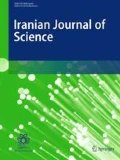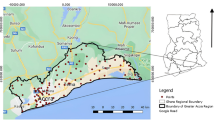Abstract
Ambient concentrations of indoor/outdoor radon and gamma dose rates (GDR) were measured, using RTM 1688–2 and Ludlum micrometer 19, in the Muzaffarabad city. For indoor radon measurements, radon concentrations varied in the range of 16 to 150 Bq m−3, whilst for outdoor environment from 7 to 31 Bq m−3. Average values of indoor and outdoor radon concentrations were found as 46.9 and 13.3 Bq m−3, respectively. For indoor measurements, GDR ranges from 419 to 1486 µGy y−1 with mean value of 846 µGy y−1, whilst outdoor GDR varied from 495 to 1029 µGy y−1 with mean value of 777 µGy y−1. For indoor measurements, annual effective dose (\({E}_{Rn}\)) due to radon exposure ranges from 0.4 to 3.78 mSv y−1 with average value of 1.18 mSv y−1. Radon doses delivered to lungs varied from 0.97 to 9.08 mSv y−1 with an average value of 2.84 mSv y−1. Excess lifetime cancer risk (ELCR) varied from 1.49 × 10−3 to 14.01 × 10−3 with mean value 4.38 × 10−3. Data of current study show that lung cancer cases per year per million person (\(Lung_{{\text{cancer cases}}}\)) ranges between 7.26 and 68.1 per million persons per year with mean value of 21.2 per million persons per year. Present study results reported for \({Lung}_{cancer cases}\) are lower than ICRP recommended values, viz. 170–230 per million persons. Average value of indoor radon value, viz. 46.9 Bq m−3, for the current study is found to be less than the reference value of 100 Bq m−3 proposed by the World Health Organization (WHO), whilst average value of outdoor gamma absorbed dose rate, viz. 88.7 nGy h−1, for the current study is found to be greater than the world average value of 54 nGy h−1 for outdoor gamma absorbed dose rate in air due to terrestrial sources.









Similar content being viewed by others
References
Baig MS, Snee LW (1995) The evidence for Cambro-Ordovician orogeny in northwestHimalayas Pakistan. Geol Soci Am 27:305
Calkins JA, Offield TW, Ali ST (1969) Geology and mineral resources ofSouthern Hazara District, west Pakistan and part of western Azad Kashmir. U.S.Geol.Surv. Prof. Report (IR) PK., 43.92 Kashmir, northwest sub-Himalayas. Pakistan J Him Earth Sci 39:39–48
Chakravarti IM, Laha RG, Roy J (1967) Handbook of methods of applied statistics, vol 1. Wiley, Hoboken, pp 392–394
Chung LK, Mata LA, Carmona MA, Shubayr NAM, Zhou Q, Ye Y, Kearfott KJ (2020) Radon kinetics in a natural indoor radon chamber. Sci Total Environ 734:139167
Fakhri Y, Mahvi AH, Rasouli amirhajeloo L, Jafarzadeh S, langarizadeh G, Zandsalimi Y, Moradi B, Mirzaei M (2015) Difference between the effective dose of radon 222 in old and new dwellings; Minab City, Iran, Int. J. Curr. Microbiol. App Sci 4 (2015) 329–337 https://en.wikipedia.org/wiki/Muzaffarabad, accessed on 19th of July 2020
IARC (1988) Monographs on the Evaluation of Carcinogenic Risk to Humans: Manmade Fibres and Radon, International Agency for Research on Cancer, Lyon, France, 1988, pp 43
ICRP (1993) Protection Against Radon-222 at Home and Works, (International Commission on Radiological Protection) ICRP Publication, 1993, pp 65
Iqbal J, Lone KJ, Hussain L, Rafique M (2020) Detrended cross correlation analysis (DCCA) of radon, thoron, temperature and pressure time series data. Phys Scr. 95:085213
Kearfott KJ, Whetstone ZD, Rafique KMM (2016) Use of a geographic information system (GIS) for targeting radon screening programs in South Dakota. J Radiat Res 57(1):84–90
Latif MA (1970) Stratigraphy and micropaleontology of Galis group of Hazara, Pakistan:Geol. Bull Univ Punjab 13:1–64
Latif MA (1973) A Cambrian age of the Abbottabad Group of Hazara. Pakistan Geol Bull Univ Punjab 10:1–20
Munir MH, Baig MS (2006) Paleogene biostratigraphy of Tattapani, Kotli Azad Azad Kashmir, northwest sub-Himalayas. Pakistan Jour Himalayan Earth Sci 39:39–48
Mustafa AA, Vasisht CM (1987) Health effects of exposure to radon and its decay products. Radiat Protect Dosim 18:179–182
Nagda, NL (1994) Radon prevalence, measurement, health risks and control, ASTM Manual Series MNL 15. ASTM Publication Code Number (PCN) 28–015094–17. West Conshohocken, PA, ASTM International, 1994
Nasir T, Matiullah, Rafique M, Rahman SU, Khalil M, Anwar N (2014) Evaluation of radon induced lung cancer risk in occupants of the old and new dwellings of the Dera Ismail Khan City, Pakistan. J Radioanal Nucl Chem 300:1209–1215
Nero AV (1988) Estimated risk of lung cancer from exposure to radon decay products in U.S Homes: a brief review. Atmosph Environ 22:2205–2211
Ojovan MI, Lee WE, Kalmykov SN (2019) An introduction to Nuclear Waste Immobilisation, 3rd Edition ISBAN 978–0–08–102702–8
Özen S, Celik N, Dursun E, Taskın H (2018) Indoor and outdoor radon measurements at lung cancer patients’ homes in the dwellings of Rize Province in Turkey. Environ Geochem Health 40:1111–1125
Rafique M, Rahman SU, Jabeen S, Shahzad MI, Rahman S, Bukhari S, Nasir T, Matiullah, (2009) Measurement and comparison of indoor radon levels in new and old buildings in the city of Muzaffarabad (Azad Kashmir), Pakistan: a Pilot study. Radioisotopes 58:749–760
Rafique M, Rahman S, Rahman SU, Jabeen S, Shahzad MI, Rathore MH, Matiullah, (2010) Indoor radon concentration measurement in the dwellings of district Poonch (Azad Kashmir) Pakistan. Radiat Protect and Dosim 138(2):158–165
Rafique M, Matiullah RSU, Rahman S, Shahzad MI, Azam B, Ahmed I, Majid A, Siddique MI (2011) Assessment of indoor radon doses received by the dwellers of Balakot – NWFP, Pakistan: a Pilot study. Carpathian J Earth Environ Sci 6(1):133–140
Rafique M, Rahman SU, Basharat M, Aziz W, Ahmad I, Lone KA, Ahmad K, Matiullah, (2014) Evaluation of excess lifetime cancer risk from gamma dose rates in Jhelum valley. J Radiat Res Appl Sci 7(1):29–35
Rahman SU, Rafique M, Matiullah AJ (2009) Indoor radon concentrations and assessment of doses in four districts of the Punjab Province – Pakistan. J Radiat Res 50(6):529–535
Rahman SU, Rafique M, Matiullah AJ (2010b) Radon measurement studies in workplace buildings of the Rawalpindi region and Islamabad Capital area. Pakistan, Build Environ 45:421–426
Rahman SU, Matiullah, Anwar J, Jabbar A, Rafique M (2010b) Indoor Radon Survey in 120 Schools Situated in Four Districts of the Punjab Province - Pakistan Indoor and Built Environment 19(2): 214–220
Roth S, Kies A, Minten V, Feide M (2002) A review of indoor radon level in Luxemburg. In: Bukart, W., Shorabi, M., Bayer, A. (Eds) Proceeding of Fifth International Conference on High Levels of Natural Radiation and Radon Areas: Radiation Dose and Health Effects. Munich, Germany, 4th-7th September 2000, pp 204
Sahu P, Panigrahi DC, Mishra DP (2014) Sources of radon and its measurement techniques in underground uranium mines – an overview. J Sustain Min 13(3):11–18
Sannappa J, Chandrashekara MS, Sathish IA, Paramesh I, Ventakaramaiah P (2003) Study of background radiations dose in Mysore city, Karnatka state, India. Rad Meas 37:55–65
Seekamp JM, Noey JD, Kwapis EH, Chung LK, Shubayr NA, Smith T, Trimas DJ, Kearfott KJ (2020) Design and characterization of an extremely sensitive, large-volume gamma-ray spectrometer for environmental samples. Health Phys 119(2):252–260
Sherafat S, Mansoura SN, Mosaferib M, Aminisani N, Yousefi Z, Maleki S (2019) First indoor radon mapping and assessment excess lifetime cancer risk in Iran. Methods X 6:2205–2216
Srivastava A, Zaman MR, Dwivedi KK, Ramachandrana TV (2001) Indoor radon level in the dwellings of the Rajshahi and Chuadanga regions of Bangladesh Radiat. Meas 34:497–500
Statistical Yearbook (2019) Statistics Azad Jammu and Kashmir. Retrieved 20 April 2020 and assessed on 19th of July 2020
Taskin H, Karavus M, Ay P, Topuzoglu A, Hindiroglu S, Karahan G (2009) Radionuclide concentrations in soil and lifetime cancer risk due tothe gammaradioactivityin Kirklareli, Turkey. J Environ Radioact 100:49–53
Tufail M, Matiullah AS, Ansari F, Qureshi AA, Khan HA (1988) Preliminary radon concentration survey in some houses of Islamabad. Nucl Tracks Radiat Meas 15:659–662
Tufail M, Khan MA, Ahmad N, Khan HA, Zafar MS (1992) Measurement of radon concentration in some cities of Pakistan. Radiat Prot Dosim 40(1):39–44
Ulbak K, Stenum B, Sørensen A, Majborn B, Bøtter-Jensen L, Nielsen SP (1988) Results from the Danish Indoor radiation survey. Radiat Prot Dosimetry 24(1–4):401–405
UNSCEAR (1993) Sources and effects of ionizing radiation. United Nation Scientific Committee on the Effect of Atomic Radiations, New York
UNSCEAR (2000) Sources and effects of ionizing radiation. United Nations, New York
Virk HS, Sharma N (2000) A survey of indoor radon and thoron levels in dwellings in Himachal Pardesh, India In: Bukart W, Shorabi M, and Bayer, A. (Eds) Proceeding of Fifth International Conference on High Levels of Natural Radiation and Radon Areas: Radiation Dose and Health Effects. Munich Germany, 4th-7th September p193
World Health Organization 2010, WHO guidelines for indoor air quality: selected pollutants, Regional Office for Europe, https://www.ncbi.nlm.nih.gov/books/NBK138705/pdf/Bookshelf_NBK138705.pdf
Yu KN, Young ECM, Stokes MJ, Guan ZJN, Cho KW (1997) A survey of indoor radon and thoron progeny for dwellings in Hong Kong. Health Phys 73(2):373–377
Acknowledgements
We are appreciative to the anonymous reviewers for their watchful reading of our manuscript and insightful recommendations that has added value in the improvement of manuscript.
Author information
Authors and Affiliations
Corresponding author
Rights and permissions
About this article
Cite this article
Rafique, M., Abbasi, S., Shahzadi, C. et al. Excessive Lifetime Cancer Risk Assessment due to Short-Term Indoor/Outdoor Ambient Radon and Gamma Dose Rate Exposures. Iran J Sci Technol Trans Sci 45, 2181–2190 (2021). https://doi.org/10.1007/s40995-021-01192-3
Received:
Accepted:
Published:
Issue Date:
DOI: https://doi.org/10.1007/s40995-021-01192-3




